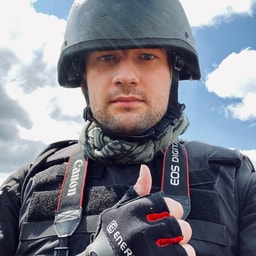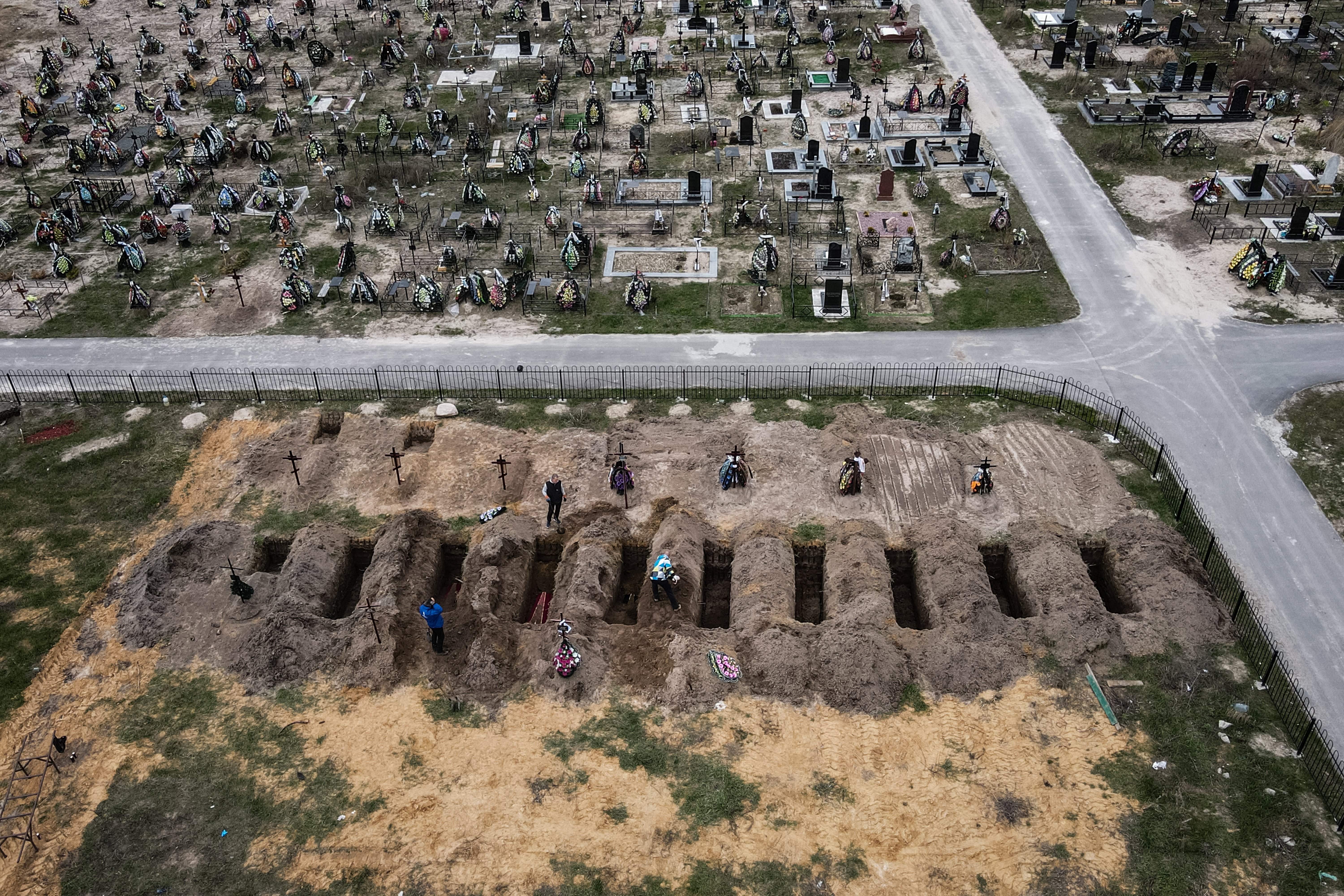Bucha massacre survivors: ‘Why do Russians hate us so much?’

BUCHA, Kyiv Oblast – Just a bit over a month ago, Bucha was a comfortable, cozy, and rapidly growing suburb just northwest of Kyiv.
The town was a place of middle-class apartment complexes and houses, surrounded by woods.
Today, Bucha is a synonym of horror known worldwide.
Russia’s defeat in the Battle of Kyiv and its rapid subsequent withdrawal in late March has unearthed things no sane mind would want to witness. Bucha is now the scene of the worst massacre committed on the European continent in the 21st century.
The Bucha massacre contains what seems like a bottomless trove of personalized evidence.
In the almost six weeks spent under Russian occupation, residents of Bucha said they were subjected to searches, robbery, torture and summary execution.
Over 410 bodies have been collected from Kyiv Oblast and submitted for forensic analysis as of April 3, according to Prosecutor General Iryna Venediktova.
A worker in Bucha who helped recover bodies and introduced himself as Serhiy, told the Kyiv Independent on April 5 that he had seen over 300. Bucha officials added that there may be dozens more in local residences and in the woods.
Many were shot at Russian checkpoints. Some were found with bound hands and fatal bullet wounds. Pictures coming out of Bucha on the first days after Ukraine’s Armed Forces went in showed people strewn across the roads, left to lie where they fell.
Some were buried by locals, while others were dragged into piles and set on fire, likely by the Russians.
The city is known to contain at least one mass grave.
“Why do they hate us so much?” cried Halyna Opalat, standing near a housing complex in Bucha, looking at the ruins across the street.
“Why? Because we’re a nation? This used to be such a beautiful city. Now it’s frightening to look at. My soul hurts.”

The Ukrainian military liberated Bucha on April 1, as the Russians were withdrawing from Kyiv Oblast. While former residents are pouring into Bucha to see if their homes survived, danger lurks all throughout the city.
Over the course of a single day, 5,000 explosive hazards were discovered in Kyiv Oblast, according to Interior Minister Denys Monastyrsky. These include mines, unexploded ordnance such as shells, missiles and bombs, as well as booby traps. Officials said that buildings in the area have been trapped with explosives, such as grenades, by the retreating Russian troops.
“The demining in Kyiv Oblast will serve as a model for the rest of the country,” Monastyrsky said.
Monthlong massacre
A brief conversation with any of the Bucha survivors unleashes a torrent of revelations of what the Russian military did to the city.
“There are lots of improvised burial places, here and there, in backyards, in dead ends,” said Vladyslava Lyubarets, a 51-year-old professor standing in a long breadline to receive newly arrived Ukrainian humanitarian aid.
“Lots and lots of people just went missing. Here in Bucha, Russians would take food, jewelry, and people would give it all up just to stay alive,” she said.
“Phones were the first thing they used to take away from us. They made people kill their poultry, and if they refused, Russians would simply shoot the hens and take the carcasses with them. For many elderly women here, that poultry was their only hope to survive.”
“Many people here had almost no food for two weeks. I will never forget the day when a senior kissed a neighbor’s hands just because she brought a boiled egg and some fresh water.”

Other Buchans also mentioned Russian soldiers bursting into their homes and seizing food, such as grains or canned goods. But that was far from the worst of what the invaders did.
Venediktova announced that Ukraine is investigating thousands of possible war crimes. It now has over 200 suspects, with material evidence of their alleged involvement.
Civilians reported that how they were treated depended on the Russian soldiers they ran into. Some didn’t touch the civilians. Others were liable to shoot on sight.
“The Kadyrovites’ checkpoint was the scariest,” said Lyubarets referring to Chechen forces loyal to Chechnya leader Ramzan Kadyrov, which Russia had deployed in the area.
“They could shoot to kill without asking questions, without checking documents. In that area, there were a lot of corpses that have now been buried on the territory of the church. Kadyrovites killed everyone – women, men, children, the age didn’t matter.”
“There were checkpoints that killed only men, ages 18-65. They checked their documents and killed them,” she continued. “There were [checkpoints] that shot some people and let others through, with no explanation.”
Lyubarets said she saw a man get shot at a checkpoint. She also relayed the story of a 14-year-old boy who ran to the shelter where her family was staying — he said his father was killed on the street.
The teen had three bullet wounds, which Lyubarets and her husband bandaged with clothing and women’s sanitary products. Several men from the shelter risked their lives to creep out, drag the body away and bury it in the yard.
For local men potentially fit for military service, things were particularly hard.

“They got me out for an execution,” said Yuriy Snegiriov, 57.
“This is what they told us: ‘We’ve been commissioned to deprive you of allowance.’ By saying that, they meant killing. We know they had an order to do that. But in my case, they eventually let me be."
Rumors spread quickly that some Russian units were hunting for men. So in many cases, the only way to stay alive was to keep a low profile for as long as possible.
“I survived just because I hid in basements all the time, keeping out of their sight,” says Oleksandr Paitsun, a younger man, also waiting in a breadline for humanitarian assistance.
“Bucha was divided into sectors. And in my sector, Russians most of the time were too busy to look more carefully. In my sector, there was a Rosgvardia (Russian National Guard) unit, like really young guys, they might let one go. But the military would not.”
"They were very ferocious," said resident Lyudmila Khoda, 79, who said her neighbors used to come back with frequent stories that someone they knew had been killed.
Some human remains have been burnt. The National Police showed journalists a pile of unidentified, charred bodies in Bucha on April 5, near a small playground.
Four of the bodies belonged to women and two to men. One of the female bodies was very small and may have been a child, said the head of the National Police in Kyiv Oblast Andrii Nebytov.

He said Russian troops most likely found the victims in a basement where they may have taken shelter, before gunning them down, then gathering the remains into a pile and setting them on fire.
“We have only started searching,” Nebytov said on April 5 when asked if there are many sites where bodies were burnt in this manner. He expects more bodies will be found in parks and forests throughout the area.
Yegor Firsov, a former Ukrainian lawmaker and now a member of the territorial defense force, would agree. After visiting Bucha, he said that the final death toll will be even higher than estimated: Many bodies are in people’s backyards and have yet to be found.
Serhiy, who helped recover and transport bodies, said that he’s seen bodies with bullet holes in their arms and legs, which he believes to be evidence of torture. Nebytov said on April 5 that earlier, five people were found shot to death, with bound hands, in a basement in Bucha.
In March, Anton Dovgopol, a director of the Irpin City Polyclinic told the Kyiv Independent that he was involved in digging a mass grave on church territory and burying 67 people there.
Satellite imagery by Maxar Technologies taken on March 31 showed a trench dug into the grounds near the Church of Saint Andrew in Bucha.

Lyubarets also said that abuse and muggings were rampant. Soldiers would stop people on the street and strip them of articles of clothing they liked. Refusing would get you shot. But it didn’t always end there.
“Sometimes they would make people strip down naked and lie on the ground, then bind their hands. They would then lie there until neighbors came to check out if they were still alive and untied them,” she said, describing a practice a different source confirmed seeing.
Forcibly visiting apartments to search them was common, multiple people told the Kyiv Independent. If a civilian didn’t leave their door unlocked or let the Russians in, they would break down the door and start shooting.
Mykola Mosyarevych, was one of the local young men who managed to survive the massacre.
He spent the whole month of Russian occupation in a basement at the Continent apartment complex, one of the best-known living quarters in Bucha. Just thanks to his neighbors, and some negligence among Russian soldiers, who once allowed them to get some food from a destroyed supermarket nearby, he also managed to survive.

Mosyarevych walks past what used to be a fancy residential complex, now heavily damaged skeletons of buildings and heaps of garbage and empty ammunition boxes. Russian paratrooper units used to occupy the complex and delivered artillery fire from among the civilian buildings.
“I just don’t get why they were doing this,” he said, slipping into tears as he walked among liberated ruins in the cold wind.
He spent much of the past month without seeing the daylight.
“I just don’t understand. Don’t understand why they would want to do this to us.”













